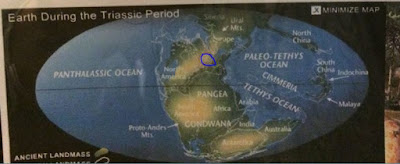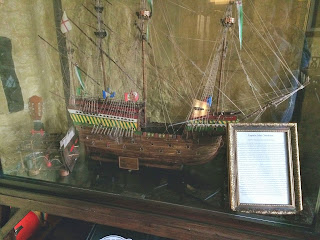Lunch was to be along the coach road or turnpike lane at The
Oxenham Arms … full of history and ancient finds … and only about ten minutes
away … we’d been a-wandering and looking in the area, so were happy to have a
lunch recommendation …
 |
| Oxenham Arms covered in autumnal Virginia Creeper - gorgeous |
Now I take you back to the Triassic period – 225 million years
ago – the world was in a huge period of change – the continents were shifting
into place …
… Pangea was still around, Gondwana had not split apart yet …
Britain was beginning to form, and was moving towards its present position …
see another of my magical rough blue pencil marks!
 |
| The blue circle is where Britain is being formed ... we have travelled some - we were down by Antartica at one stage ... and we are still in two parts ... one day I'll do a post! |
Early dinosaurs walked the earth … the granite of Dartmoor,
used in the floors and walls of The Oxenham Arms was formed 290 – 300 million
years ago as the earth’s crusts collided forming granite magma.
 |
| Unusual granite entrance arch |
The climate during the Triassic period was considerably warmer
than Devon today being much like Indonesia … petrified agatised fossil wood found in the locality matches that found in
Madagascar … a dinosaur could have brushed against the West Country trees 225
million years ago.
 |
| South Zeal village |
Caves found in Devon are famed for the remains of extinct
animals and evidence of man’s early occupation of our islands – bones of hyenas,
woolly rhinoceros, cave lion, cave bear, reindeer, sabre-tooth tiger and bison.
 |
| Smilodon - sculpted by Erich Oehme (1064) - to be found in Tierpark Berlin |
The Sabre-Tooth Tiger or Smilodon looked similar to a cat …
however they were heavy weights and more the size of a horse. As you can see its two front teeth were over
12 inches long.
This ‘Granite Squeezing’ formed minerals including the copper
and tin of the West country … these metals were exploited by the Bronze Age
peoples around 4,000 years ago …
 |
| Suit of Armour outside the dining room |
… with extensive trading being built up between Britain and
what we now know as Europe, down south to Mesopotamia in the Middle East. Fur routes on the rivers had opened up
trading routes across northern Europe …
 |
| Details re the Menhir ... |
The Oxenham Arms at South Zeal has one last hidden treasure,
which has been built into this Coaching Inn.
Around 1,000 years before Stonehenge, Neolithic man carved the
South Zeal Menhir Standing Stone from granite (i.e. 6,000 years ago) ...
… then in
the early 12th century Benedictine Monks built a Monastery around
the Standing Stone … now to be found in the ‘Snug Bar’ in the middle of the hotel.
As you can see in the photo … the Menhir is at least 25 feet
in height … archaeological digs in the 1930s dug down another 14 feet and DID
NOT REACH the bottom of the stone … so how long it is no-one, for now, knows …
 |
| Shale Rock at Hope's Nose on the south Devon coast; there's a raised beach here ... showing that the sea levels were much higher |
It was found to be embedded in shale rock and was most likely
used for ceremonial purposes. Shale
rock is composed of mud that is a mix of flakes … and ‘easily’ splinters.
 |
| Model of Captain Oxenham's ship |
Captain John Oxenham, Earl of Oxenham, sailed with Drake, and
was the first sea captain to sail the Pacific before the fate of gold and the
Spaniards caught up with him – he was executed before Drake could rescue him.
‘The Ox’ has been featured in many novels including Charles
Kingsley’s “Westward Ho” … Charles Dickens wrote Pickwick Papers here, Admiral
Nelson, the Reverend Sabine Baring Gould, who wrote the hymn ‘Onward Christian
Soldiers’, have stayed here …
It was an interesting place for lunch before we hot-footed
down to the coast and our next night at Paignton. We both had the game terrine with apple and
damson chutney.
We were happy to see this former 12th century
monastery built around a pre-historic standing stone … and were glad not to have
missed the sight of South Zeal Menhir!
Hilary Melton-Butcher
Positive Letters
Inspirational Stories








































